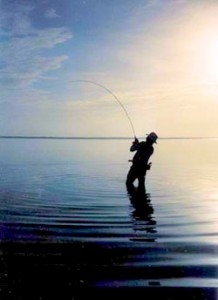 It’s time again to return to our series on fly fishing for beginners, and today, we begin looking at fly fishing tackle.
It’s time again to return to our series on fly fishing for beginners, and today, we begin looking at fly fishing tackle.
When I first got started in the sport, so many elements of fly fishing seemed almost mystical. Besides casting (which we will be getting to soon, I promise!), fly fishing tackle seemed especially alien. It seemed like more of an art than anything else. If you are feeling this way as well, I don’t want you to worry—it really isn’t that difficult to get a handle on!
Let’ take a look at fly fishing tackle and take some of the mystery out of it all. Remember, at the most basic level, all you need is a rod, a reel, a box of flies, and a place to fish!
Choosing A Rod
In fly fishing, it all starts with a fly rod. We fly fishers are inclined to spend hours learning about them, and more money than any of us would like to admit buying them!
It’s important to note that it is not possible to own one rod for all of your fishing. Fly rods are tools that have specific applications. However, it is possible to start with one rod that will serve most of your fishing very well.
Fly Rod Weights
You will here people say things like, “I’m fishing with a four weight today.” This does not have anything to do with the weight of the rod itself, rather, it refers to the line weight that the rod is built for. So, a four weight rod is built to carry four weight line. Confused? Don’t be—it’s as simple as matching the line weight with a rod that has the same weight.
Getting started in fly fishing, it is a good idea to choose a rod that will facilitate most of your fishing. That weight will be a 5 weight rod. This will handle most trout fishing, will handle some bass fishing, and will allow you to fish for many other species is well.
My advice to the beginner is always the same: Start with a good 5 wt. rod—it will serve you well, and be enough for most of your training.
Fly Rod Length
Most fly rods are going to be between 7 ft. and 9 ft. long. Anything longer or shorter is going to be a specialized casting tool.
In addition to the length, you will notice that fly rods, being so long, come in pieces. 20-25 years ago, all fly rods were two pieces. If a rod were to come in four pieces, it was considered a travel rod. The additional pieces created more friction and “dead spots” on the rod when it came to casting.
Modern manufacturing has changed all of this, and you will find many quality rods with four piece construction. They cast just as well as their two piece counterparts, and you get the benefits of additional portability.
Beware of buying a rod with any more than four pieces, unless you have a specific need for something like that. Honestly, I can’t think of anytime I’ve been fishing and said, “Gee, I wish I had a 7 piece rod today!” It doesn’t happen, so just leave them alone.
Fly Fishing Reels
Fly reels are not nearly as important as they are in traditional fishing. Since the reel plays absolutely no part in casting, they serve other purposes. In small stream fishing, and most trout fishing, the reel doesn’t even play a part in landing the fish (this isn’t true for saltwater fly fishing or for larger species such as salmon).
The reel does play an important part in counterbalancing the rod, and making casting and fishing easier. For this reason, it is important to match them up. Get a reel that is too light, and your rod tip will feel very heavy, because there is no counterbalance. Get a reel that is too heavy, and your whole rig will feel awkward and heavy.
There is more to fly fishing reels than that, but for the beginner, the most important thing to understand is simply matching up the weight with the rod. All reels have a size guide and it’s very easy to do.
See, I told you this stuff was simple!
In the interest of keeping this readable for you, we will be revisiting tackle in our next installment, when we talk about fly line, leaders, and tippet.
See ya on the water…